Initiatives for combating
climate change
Controlling air pollution and global warming
Methane accounts for about 99% of the natural gas produced by our group in Chiba Prefecture, which contains almost no carbon monoxide or sulfur that causes pollution. Thus, it is a clean energy source compared to the coal and petroleum, as the gas produces overwhelmingly less combustion emissions of carbon dioxide, which fuels global warming, and nitrogen oxides, which cause air pollution.
It is very safe even if a gas leak occurs, as it will diffuse into the atmosphere in the open air because of its low specific gravity. Furthermore, the heat generation is high at about 39 MJ, so it can be used as is for city gas and it is very efficient. In addition, since all the natural gas produced is consumed in Chiba Prefecture (local production for local consumption), compared to natural gas (LNG) imported from overseas, greenhouse gas emission for production and transportation is about 1/3 (according to a survey by our group), making ours an extremely environmentally friendly energy source.
Comparison in emissions among fuels when combusted
| Comparison in CO2 emissions(1) | Comparison in SOx emissions(1) | Comparison in NOx emissions(2) |
|---|---|---|
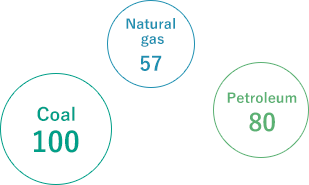 |
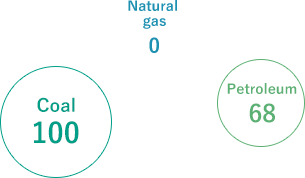 |
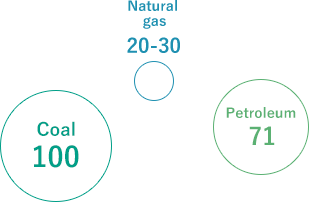 |
Scroll
Sources
- 1.Natural Gas Prospects to 2010, IEA (International Energy Agency), 1986
- 2.Report on Demonstrative Surveys on Technologies for Evaluating the Effects of Thermal Power Plants on the Atmosphere, the Institute of Applied Energy, March 1990
Comparison in LCI between natural gas produced in Chiba Prefecture and others
Volume of carbon dioxide emitted during processes from production to combustion of resources
- *The parenthesis represents the ratio to the value of natural gas produced in Chiba Prefecture.
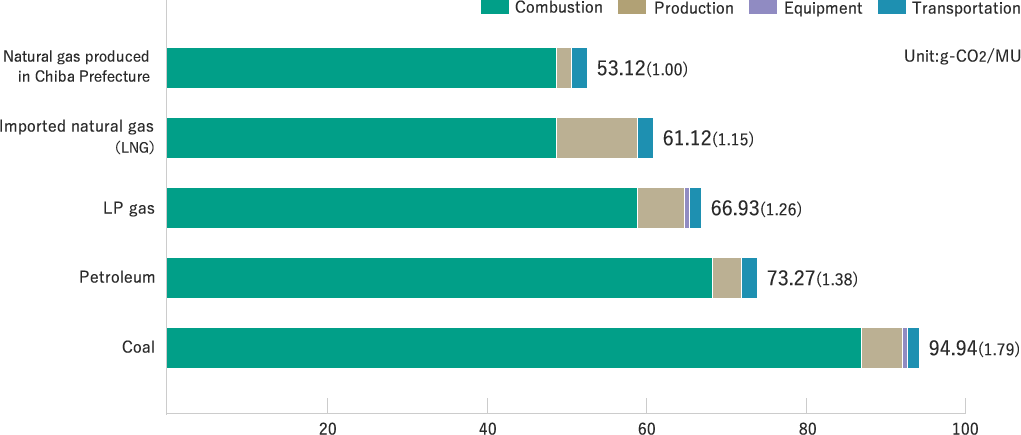
Scroll
- *Estimated by our corporate group with reference to “Life Cycle Inventory Analysis of Fossil Energies in Japan” (1999) by the Institute of Energy Economics, Japan
Stable production and supply of domestic natural gas
As a producer of natural gas, an important energy source that will play a leading role in the transitional period toward carbon neutrality by 2050, and as one of the largest producers of natural gas dissolved in water in Japan, we are promoting the sustainably stable production and supply of gas.
Under our Medium-Term Management Plan 2027, we aim to achieve a domestic natural gas production volume of 180 million m³ per year by promoting the maintenance and expansion of production facilities and adopting new technologies and equipment for aged wells.
For details of the natural gas dissolved in water produced by our group in Chiba Prefecture, please refer to the website of Kanto Natural Gas Development Co., Ltd., which is responsible for the development and production of natural gas in the group.
600 years’ worth of reserves | Kanto Natural Gas Development Co., Ltd.
Pursuing renewable energy-related businesses, including geothermal and offshore wind power generation
In our geothermal power generation and geothermal well drilling businesses, we will leverage our long-standing expertise in underground resource development gained through our natural gas business, along with WELMA’s technical expertise and track record in geothermal well drilling. We will advance our geothermal exploration business in the southern foothills of the Mt. Kurikoma while expanding our geothermal well drilling business.
In the offshore wind power generation business, we will leverage the trust and track record we have built as a community-oriented company in Chiba Prefecture to pursue the challenge of offshore wind power development in the region.
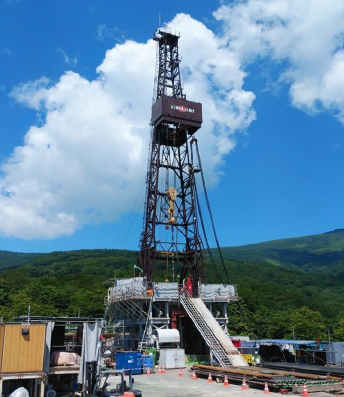
Geothermal well drilling rig

renewable energies
Initiatives toward carbon neutrality
Starting with the development of renewable energy, we will promote initiatives toward carbon neutrality.
Under our Medium-Term Management Plan 2027, we will explore and implement various initiatives to support carbon offsetting and the advanced use of domestic natural gas, with a view to achieving carbon neutrality.
Roadmap toward carbon neutrality (conceptual overview)

Initiatives for the TCFD Recommendations
Governance
- We have identified the important social issues (= material issues) for our corporate group, such as “contribution to measures against climate change” and “conservation of the natural environment.”
- After examining the impact of these issues on our corporate group, discussing how to cope with it within our corporate group, and reviewing our corporate group’s management philosophy, we have declared that “we will contribute to the realization of a sustainable society by operating businesses that can harmonize with the environment and coexist with local communities.”
- Based on this new management philosophy, we have formulated a medium-term management plan that includes measures to address climate change risks through discussions at the Group Executive Committee (composed of the presidents and others of group companies) and the Board of Directors. Its progress is reported to and managed by the Board of Directors on a quarterly basis.
Strategies
Scenario analysis
- Using scenarios from the World Energy Outlook of the International Energy Agency (IEA) and the Intergovernmental Panel on Climate Change (IPCC), transition risks, physical risks, and opportunities were analyzed based on trends in carbon prices, trends in the supply and demand of resources, forecast data on the composition of power generation by power source, and the degree of likelihood of damage to infrastructure, etc. caused by climate change.
Recognizing the risks and opportunities due to climate change
| Category | Risk/opportunity | Discussion (risk) | Discussion (opportunity) | |
|---|---|---|---|---|
| Transition | Policy/regulation | Carbon emission goal | If regulations are tightened, the consumption of fossil fuels will decline, the production volume of gas and iodine will decrease, and then sales will drop. Expenses will augment due to carbon credits. | Natural gas, which emits a smaller volume of CO2 than other fossil fuels, is increasingly used as the energy that supports the transition period to carbon neutrality in 2050. |
| Transition | Policy/regulation | Carbon price | Due to the rise in carbon price, fossil fuels will become less economical and demand for them will decline (the sales of gas will drop), affecting our sales. | Through the development of the carbon tax market, there is a possibility that new opportunities will emerge in the low-carbon energy market, including hydrogen, CCU, and decentralized utilities. |
| Transition | Market | Change in the energy mix | The ratio of power generation using fossil fuels will decrease, leading to the decline in the production volumes of natural gas and iodine, and then affecting our sales. | Due to the increase of power generation using renewable energy, new businesses will expand. |
| Transition | Market | Change in the demand for energy | Fossil fuels will be avoided, the production volumes of natural gas and iodine will decrease, and sales will drop. | There is a possibility that new opportunities will emerge in the low-carbon energy market, including hydrogen, CCU, and decentralized utilities. New technologies for methanation, etc. will advance. |
| Transition | Policy/regulation | Energy-saving policy | Due to the decline in gas consumption, the production volumes of natural gas and iodine will decrease, and sales will drop. | Gas consumption will increase, due to the distribution of highly efficient gas devices with high added value. |
| Physical | Rapid | Intensification of abnormal weather | The damage to production/supply facilities would disturb supply, and sales would drop. The investment in anti-disaster measures would increase. | Gas would be adopted for diversifying energy sources in preparation for the shut-off of energy due to weather disasters, and sales would increase. The resilience of equipment will be enhanced. |
Scroll
Strategies
- We will push ahead with the development of domestic natural gas that contributes to the promotion of a low-carbon society and expand sales as natural gas with high environmental superiority.
- We will promote new businesses centered on renewable energy.
- We will promote the procurement of carbon-neutral materials and carbon-neutral electricity.
Risk management
- Climate change risks are evaluated and managed as part of managing the progress of the Medium-Term Management Plan, and the progress is reported to the Board of Directors quarterly. We also formulate a specific action plan each year after the discussions at the Group Executive Committee and the Board of Directors of our company in order to respond appropriately to changes in the situation.
Metrics and objectives
- In light of these circumstances, our Group has set the following target values as part of the Medium-Term Management Plan 2027.


